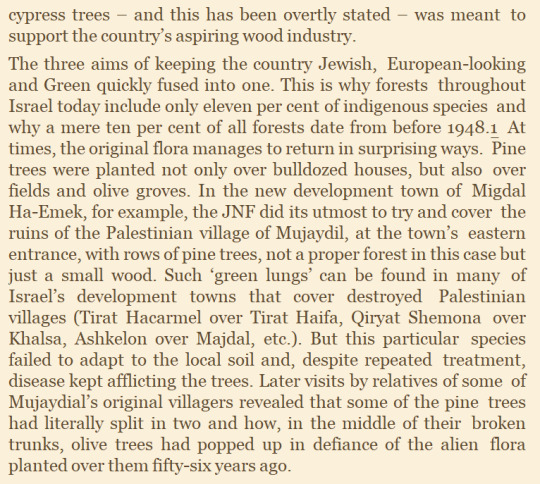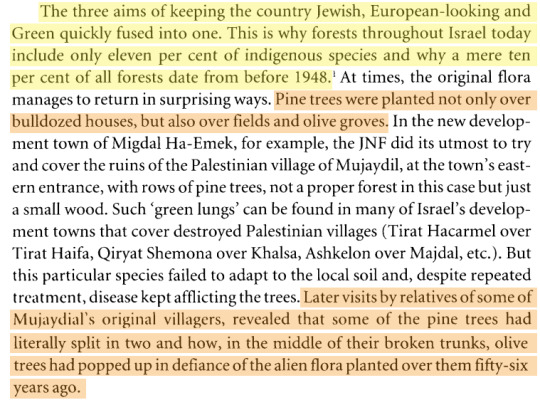#mujaydil
Explore tagged Tumblr posts
Text


The Ethnic Cleansing of Palestine - Ilan Pappé (2006)
#the rejoicing that must have occurred - i can imagine word spread fast#zionists probably took this as a personal attack by nature. good.#The Ethnic Cleansing of Palestine#Ilan Pappé#Palestine#Israel#Free Palestine#Free Gaza#ethnic cleansing#zionism#nsnv#colonialism#atypicalreads#politics#history#state of israel#nonfiction#olive trees#Ilan Pappe#mujaydil#conifers#natural flora#indigenous#cypress#pine#trees#migdal ha-emek#jnf#jewish national fund#green lungs
160 notes
·
View notes
Text
At times, the original flora [of Palestine] manages to return in surprising ways. Pine trees were planted not only over bulldozed houses, but also over fields and olive groves. In the new development town of Migdal Ha-Emek, for example, the JNF did its utmost to try and cover the ruins of the Palestinian village of Mujaydil, at the town’s eastern entrance, with rows of pine trees, not a proper forest in this case but just a small wood. Such ‘green lungs’ can be found in many of Israel’s development towns that cover destroyed Palestinian villages (Tirat Hacarmel over Tirat Haifa, Qiryat Shemona over Khalsa, Ashkelon over Majdal, etc.). But this particular species failed to adapt to the local soil and, despite repeated treatment, disease kept afflicting the trees. Later visits by relatives of some of Mujaydial’s original villagers revealed that some of the pine trees had literally split in two and how, in the middle of their broken trunks, olive trees had popped up in defiance of the alien flora planted over them fifty-six years ago.
—Ilan Pappé, from The Ethnic Cleansing of Palestine
6K notes
·
View notes
Text

“The three aims of keeping the country Jewish, European-looking and Green quickly fused into one. This is why forests throughout Israel today include only eleven per cent of indigenous species and why a mere ten per cent of all forests date from before 1948.1 At times, the original flora manages to return in surprising ways. Pine trees were planted not only over bulldozed houses, but also over fields and olive groves. In the new development town of Migdal Ha-Emek, for example, the JNF did its utmost to try and cover the ruins of the Palestinian village of Mujaydil, at the town's eastern entrance, with rows of pine trees, not a proper forest in this case but just a small wood. Such 'green lungs' can be found in many of Israel's development towns that cover destroyed Palestinian villages (Tirat Hacarmel over Tirat Haifa, Qiryat Shemona over Khalsa, Ashkelon over Majdal, etc.). But this particular species failed to adapt to the local soil and, despite repeated treatment, disease kept afflicting the trees. Later visits by relatives of some of Mujaydial's original villagers, revealed that some of the pine trees had literally split in two and how, in the middle of their broken trunks, olive trees had popped up in defiance of the alien flora planted over them fifty-six years ago.”
— The Ethnic Cleansing of Palestine, by Ilan Pappé (2006, p. 227-228.)
18 notes
·
View notes
Text
ID by @swosheep
[Image ID]
A screenshot from an article that reads: "The three aims of keeping the country Jewish, European-looking and Green quickly fused into one. This is why forests throughout Israel today include only eleven per cent of indigenous species and why a mere ten per cent of all forests date from before 1948. At times, the original flora manages to return in surprising ways. Pine trees were planted not only over bulldozed houses, but also over fields and olive groves. In the new development town of Migdal Ha-Emek, for example, the JNF did its utmost to try and cover the ruins of the Palestinian village of Mujaydil, at the town's eastern entrance, with rows of pine trees, not a proper forest in this case but just a small wood. Such 'green lungs' can be found in many of Israel's development towns that cover destroyed Palestinian villages (Tirat Hacarmel over Tirat Haifa, Qiryat Shemona over Khalsa, Ashkelon over Majdal, etc.). But this particular species failed to adapt to the local soil and, despite repeated treatment, disease kept afflicting the trees. Later visits by relatives of some of Mujaydial's original villagers, revealed that some of the pine trees had literally split in two and how, in the middle of their broken trunks, olive trees had popped up in defiance of the alien flora planted over them fifty-six years ago."
[/End ID]
I'm reading about how Israel, in the immediate aftermath of the 1948 Nakba, deliberately replaced olive trees and other indigenous flora with European plants. This ecological disaster, which is now proudly hailed under the banner of 'making the desert bloom,' was done to 'de-Arabize' the landscape, and to cover up - often with fast-growing European pine trees -the ruins of Palestinian villages that were destroyed by Zionists forces.
And I just need everyone to read this passage from Pappé, because the symbolism of what happened to those European pine trees in the desert speaks for itself:

The Ethnic Cleansing of Palestine, by Ilan Pappé (2006, p. 227-228.)
56K notes
·
View notes
Text

The Ethnic Cleansing of Palestine - Ilan Pappé (2006)
#Nazareth#Malul#Mujaydil#Migdal Ha-Emeq#mosque#church#The Ethnic Cleansing of Palestine#Ilan Pappé#Palestine#Palestinians#free palestine#free gaza#israel#ethnic cleansing#zionism#nsnv#colonialism#nakba#atypicalreads#politics#history#state of israel#ideology#nonfiction#Ilan Pappe
3 notes
·
View notes
Text



The Ethnic Cleansing of Palestine - Ilan Pappé (2006)
#this part gives much hope and humanity in coexistence#Mujaydil#Nazareth#Christians#Muslims#kuttab#Russian Orthodox#Roman Catholic#Nakba#Nahalal
2 notes
·
View notes
Photo
Garnier is a brand owned by L'Oreal, which is a 'warm friend of Israel'. After sending a letter to the Arab League with information helping the boycott, they paid a $1.4m fine and issued an apology, before fostering a new relationship with Israel, with heavy investment and even operating a factory in Occupied Palestine.
L’Oreal have worked in Israel since 1990 and their L’Oreal Israel factory operates in Migdal Ha’emek, or rather al-Mujaydil, an occupied Palestinian village. They also use Dead Sea minerals, benefitting from the occupied Palestinian West Bank hosting one third of the Dead Sea shore.
L’Oreal’s activities in Israel are not, however, limited to L’Oreal Israel. While Palestinian academics and students in the occupied territories and Israel are systematically impeded by Israeli occupation roadblocks and other oppressive measures from conducting normal academic life and research, L’Oreal awarded a $100,000 “lifetime achievement” award to a scientist at Israel’s Weizmann Institute of Science in July 2008. The Weizmann Institute, since its establishment, has been a major center for clandestine research and development of nuclear, chemical and biological weapons on behalf of Israel’s military establishment with which it has close ties. It is, therefore, one of many academic institutions in Israel that are in collusion with the state’s violations of international law and Palestinian human rights, and which are targeted for academic boycott by the Palestinian Campaign for the Academic and Cultural Boycott of Israel (PACBI).
"We are pleased to hear that Garnier have distanced themselves from the attempt to associate them with the Israeli Forces. It is a pity they did not respond earlier to numerous messages asking them to do so. The Israel lobby group, Stand With Us, claim that Garnier Israel donated the packages to the soldiers. Therefore we urge Garnier to take the issue up with them and issue an urgent statement clarifying whether the company did or did not donate care packages."

Palestinians don’t have basic humanitarian supplies. No food or clean water and the Israeli army is given luxuries.
Never buy Garnier. Filth.
[@selintifada]
#I get the vibe you're someone who gets your hackles up at the word intifada because it's arabic though so 🤷🏻#I mean you already accused me of speaking over myself in a different post and have made several condescending genocide apologia comments#so this is more for the others seeing your comments#bds
48K notes
·
View notes
Text
[ID: Text that reads: The three aims of keeping the country Jewish, European-looking and Green quickly fused into one. This is why forests throughout lsrael today include only eleven per cent of indigenous species and why a mere ten per cent of all forests date from before 1948. At times, the original flora manages to return in surprising ways. Pine trees were planted not only over bulldozed houses, but also over fields and olive groves. In the new development town of Migdal Ha-Emek, for example, the JNF did its utmost to try and cover the ruins of the Palestinian village of Mujaydil, at the town's eastern entrance, with rows of pine trees, not a proper forest in this case but just a small wood. Such 'green lungs' can be found in many of lsrael's development towns that cover destroyed Palestinian villages (Tirat Hacarmel over Tirat Haifa, Qiryat Shemona over Khalsa, Ashkelon over Majdal, etc.). But this particular species failed to adapt to the local soil and, despite repeated treatment, disease kept afflicting the trees. Later visits by relatives of some of Mujaydial's original villagers, revealed that some of the pine trees had literally split in two and how, in the middle of their broken trunks, olive trees had popped up in defiance of the alien flora planted over then fifty-six years ago. End ID]
(ID taken from alt text.)
I'm reading about how Israel, in the immediate aftermath of the 1948 Nakba, deliberately replaced olive trees and other indigenous flora with European plants. This ecological disaster, which is now proudly hailed under the banner of 'making the desert bloom,' was done to 'de-Arabize' the landscape, and to cover up - often with fast-growing European pine trees -the ruins of Palestinian villages that were destroyed by Zionists forces.
And I just need everyone to read this passage from Pappé, because the symbolism of what happened to those European pine trees in the desert speaks for itself:

The Ethnic Cleansing of Palestine, by Ilan Pappé (2006, p. 227-228.)
56K notes
·
View notes
Text
Transcription of text in screenshot:
The three aims of keeping the country Jewish, European-looking and Green quickly fused into one. This is why forests throughout Israel today include only eleven per cent of indigenous species and why a mere ten per cent of all forests date from before 1948.
At times, the original flora manages to return in surprising ways. Pine trees were planted not only over bulldozed houses, but also over fields and olive groves. In the new development town of Migdal Ha-Emek, for example, the JNF did its utmost to try and cover the ruins of the Palestinian village of Mujaydil, at the town's eastern entrance, with rows of pine trees, not a proper forest in this case but just a small wood. Such 'green lungs' can be found in many of Israel's development towns that cover destroyed Palestinian villages (Tirat Hacarmel over Tirat Haifa, Qiryat Shemona over Khalsa, Ashkelon over Majdal, etc.).
But this particular species failed to adapt to the local soil and, despite repeated treatment, disease kept afflicting the trees. Later visits by relatives of some of Mujaydial's original villagers, revealed that some of the pine trees had literally split in two and how, in the middle of their broken trunks, olive trees had popped up in defiance of the alien flora planted over them fifty-six years ago
End transcription.
I'm reading about how Israel, in the immediate aftermath of the 1948 Nakba, deliberately replaced olive trees and other indigenous flora with European plants. This ecological disaster, which is now proudly hailed under the banner of 'making the desert bloom,' was done to 'de-Arabize' the landscape, and to cover up - often with fast-growing European pine trees -the ruins of Palestinian villages that were destroyed by Zionists forces.
And I just need everyone to read this passage from Pappé, because the symbolism of what happened to those European pine trees in the desert speaks for itself:

The Ethnic Cleansing of Palestine, by Ilan Pappé (2006, p. 227-228.)
#I know there is#Alt text#But adding the transcription in case helpful#Described#Thank you for the alt text#Ilan Pappé#The ethnic cleansing of Palestine#To read
56K notes
·
View notes